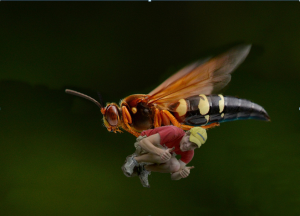Across the state reports of gigantic, flying manhunters have hit my ears. Reports of giant wasps that are capable of digging massive holes in residents’ yards and reports of these wasp invaders carrying away grasshoppers to their lairs never to be seen or heard from again keep pouring in. There’s a lot of concern about these monster wasps and what they’re doing, but yet not one report of a wasp uprising against a local South Dakotans or even a single sting… Seems a little strange that such a terrifying beast hasn’t mounted a single attack against we humans right?
The reports coming in are in regards to what are commonly called “Cicada Killers” or “Digger Wasps”, Sphecius speciosus (Drury) (Insecta: Hymenoptera: Sphecidae). Now don’t get me wrong… These are some pretty intimidating insects- they measure up to a couple inches in length, females have a large stinger or ovipositor, and when in flight, these wasps have the roar of an Apache helicopter as they fly past your face. Needless to say, but they have trouble making friends.
Here’s a terrific picture from Jay D. of Koolpix that shows a typically cicada killer in flight.
But this is what most people see…
So we’ve established what they are, but where did they come from and what are they doing? Well cicada killers are quite the busy bees wasps. Females in particular are occupied with three primary tasks:
- Dig a hole or burrow (they’re solitary and don’t live in nests like you might expect)
- Fill that hole with paralyzed cicadas or other insects to feed to their young
- Scare the hell out of everyone
Ok… so they only have 2 real tasks, but if you ask anyone they would probably agree with the third task listed! Just ask. You’ll notice though that attacking people isn’t on the list. They could honestly careless about what we’re doing as long as we’re not trying to bat them out of the air. These wasps are gentle giants (unless you’re a cicada). Unlike other wasps and honeybees, cicada killers lack the nest-guarding behavior that makes the other bees and wasps temperamental and more likely to sting. Therefore, we can walk through swarms of these guys with little to no concern of being stung. And, with that in mind, I wouldn’t swat at them… They have a pretty nasty sting.
We’ve been seeing them a lot this year because the conditions are just right. They prefer areas that are well drained or dry, light soils, areas that are in full sunlight most of the day, and they definitely like to be near trees that are full of cicadas. That’s why so many of us are finding them in our gardens, lawns, and near our sidewalks. It can be upsetting to see these wasps dig up the soil in these areas, but if you stop and watch them move pounds of soil with those tiny little stick legs I bet you’d be more impressed than upset!
So the next time you’re being pinned down by these critters just remember the words of pure wisdom that have been typed above, take a deep breath, and run like hell like the rest of us! appreciate what they have to offer (a peaceful nights rest without the blasting noise generated by those cicadas).


